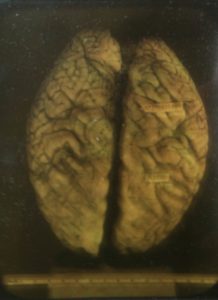by Jack El-Hai, Wonders & Marvels contributor
After the end of World War II, a Nazi leader dies in Allied custody under strange circumstances. An American military psychiatrist longs to prove his pet theory by having the Nazi’s brain removed from the body and examined. With help from a friend, the psychiatrist succeeds in extracting the organ and smuggling it out of Europe. A pathologist studies the brain to determine the correctness of the psychiatrist’s theory and the result is. . .well, it’s complicated.
This happened, not in a bad science fiction film of the 1960s, but in real life, in Nuremberg, Germany; Washington, D.C.; and beyond.
I first came across the story while researching my book The Nazi and the Psychiatrist: Hermann Göring, Dr. Douglas M. Kelley, and a Fatal Meeting of Minds at the End of WWII. One of the first artifacts I encountered among the records of Douglas Kelley, M.D., a psychiatrist who had exclusive access to the top captured German leaders awaiting trial in Nuremberg for war crimes, was a set of glass slides. The slides showed different views of a dissected human brain. The label on the slides said the brain came from a man named Robert Ley.
I knew Ley as the emotionally unstable and hard-drinking head of the German Labor Front, a Nazi government agency that replaced trade unions and took charge of the affairs of German workers. Under Ley’s direction, the organization played a role in the gathering and mobilization of slave laborers, many of whom suffered and died in criminally brutal conditions.
Kelley met Ley during the summer of 1945, when the German was imprisoned and awaiting trial with 21 of the most culpable of his colleagues from the Nazi government and German military. The psychiatrist had assigned himself the task of determining whether a common mental disease or disorder afflicted the captured Germans and could explain their crimes against humanity. Ley, with his spells of shouting, crying, and proclaiming his allegiance to Adolf Hitler, was a subject of interest to Kelley.
Through the use of Rorschach inkblot testing and other psychological assessments, Kelley theorized that Ley — alone among the top German defendants — suffered from a behavioral disorder originating in the brain, the result of an airplane crash Ley had experienced World War I. Kelley’s tentative diagnosis of organic brain injury was bold, given the psychiatrist’s lack of access to any kind of brain imaging when examining Ley.
Ley became his Allied captors’ nightmare when he managed to strangle himself in his Nuremberg cell in October 1945. Kelley called Ley’s suicide a blessing, because it offered hope that the dead man’s brain could testify to the truth of Kelley’s brain-damage diagnosis. Kelley convinced a friend, U.S. Army pathologist Najeeb Klan, to secretly remove Ley’s brain in the Nuremberg morgue. Kelley then sent the brain, enclosed in a wooden crate marked “Spices,” on a transatlantic journey. It soon reached another of Kelley’s colleagues, neuropathologist Webb Haymaker, at the Army Institute of Pathology in Washington , D.C. In the process, it became the only brain of a Nazi leader given post-mortem scrutiny. Kelley asked Haymaker to examine the brain for signs of frontal-lobe damage.
Haymaker wrote back to Kelley that Ley’s brain evidenced “a long-standing degenerative process of the frontal lobes.” He couldn’t tell if a head injury caused the degeneration. Nevertheless Kelley felt exhilarated by the supposed prescience of his chancy diagnosis.
Joel E. Dimsdale, distinguished professor emeritus and research professor in the department of psychology at the University of California, San Diego, has unearthed more about the silent testimony of Ley’s brain. In his research, he quotes Nathan Melamud of the Langley Porter Neuropsychiatric Institute, who in 1947 took his own look at Ley’s brain tissue at Haymaker’s request. “I am not impressed with any definite pathology in this case,” Melamud wrote, “at least such as would lead one to suspect a clinical organic condition…. [I]f real, the changes are not too significant.”
Kelley’s reaction to this less affirming second opinion is unknown. He had other things to ponder. By 1947, Kelley was deeply into the writing of a book that laid out his proposition that the German leaders had been infected by no psychiatrically active “Nazi virus” that accounted for their behavior. That declaration — and its implication that the German leaders were psychiatrically normal — did not go down well with the American public.
Further reading
Dimsdale, Joel E. Anatomy of Malice: The Enigma of the Nazi War Criminals. Yale University Press, 2016.
Smelser, Ronald. Robert Ley: Hitler’s Labor Leader. Berg, 1988.

